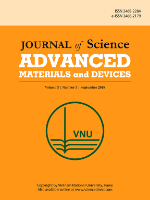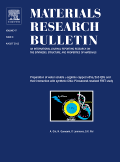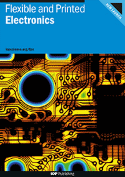
Electronic Materials Letters
Scope & Guideline
Advancing the Future of Electronic Materials
Introduction
Aims and Scopes
- Synthesis and Characterization of Nanostructured Materials:
Research focusing on various synthesis methods such as chemical vapor deposition, sol-gel, and electrochemical techniques to create nanostructured materials for electronic applications. - Development of Semiconductor and Dielectric Materials:
Investigations into the fabrication and properties of semiconductor materials, including thin films and heterostructures, as well as dielectric materials for capacitors and other electronic components. - Electrochemical and Photocatalytic Applications:
Studies on materials used for electrochemical applications, including batteries and supercapacitors, and photocatalytic activities for environmental applications. - Flexible and Wearable Electronics:
Research on materials and devices that enable flexible, stretchable, and wearable electronics, focusing on their mechanical stability and electrochemical performance. - Thermoelectric and Magnetic Materials:
Exploration of materials that exhibit thermoelectric and magnetic properties, including their potential applications in energy conversion and magnetic devices. - Interface and Surface Engineering:
Studies focusing on the optimization of interfaces and surfaces in electronic devices to enhance performance, reliability, and stability. - Device Fabrication and Performance Optimization:
Research aimed at the fabrication of electronic devices such as transistors, sensors, and photovoltaic cells, with an emphasis on performance enhancement strategies.
Trending and Emerging
- 2D Materials and Heterostructures:
The exploration of two-dimensional materials, particularly graphene and transition metal dichalcogenides, has seen a rapid increase. Their unique properties make them suitable for a variety of electronic and optoelectronic applications. - Organic and Hybrid Electronics:
There is a growing focus on organic semiconductors and hybrid systems, especially in light of their potential for low-cost, flexible electronics and their application in organic light-emitting diodes (OLEDs) and organic photovoltaics. - Smart and Functional Materials:
Research into smart materials that respond to external stimuli (e.g., temperature, light) is on the rise, indicating a trend towards multifunctional materials that can be used in advanced electronic systems. - Energy Storage and Conversion Technologies:
Significant advancements are being made in materials for energy storage and conversion, including batteries and supercapacitors, driven by the demand for efficient energy solutions in portable electronics. - Machine Learning and AI in Materials Science:
An emerging trend is the integration of artificial intelligence and machine learning techniques in materials discovery and characterization, paving the way for innovative material design. - Sustainability and Eco-Friendly Materials:
Research focusing on sustainable materials and processes is gaining traction, reflecting a broader trend in science towards environmentally friendly technologies and practices.
Declining or Waning
- Conventional Silicon-Based Devices:
Research focusing on traditional silicon-based electronic devices has seen a decline as the field shifts towards exploring alternative materials like perovskites and organic semiconductors. - Basic Conductivity Studies without Application Focus:
Studies that primarily focus on basic conductivity measurements without tying the results to specific applications are becoming less frequent, as there is a growing demand for applied research that directly impacts device performance. - Bulk Material Studies:
Research on bulk materials without nanoscale or structural modifications has decreased in favor of studies that explore nanostructured and composite materials, which offer enhanced properties for electronic applications. - Inert Gas Synthesis Techniques:
Synthesis methods that rely solely on inert gases without innovative modifications or enhancements are waning, as researchers are seeking more efficient and environmentally friendly synthesis routes.
Similar Journals

Journal of Science-Advanced Materials and Devices
Leading the Charge in Cutting-Edge Materials ResearchJournal of Science-Advanced Materials and Devices is a leading open-access journal published by Vietnam National University, dedicated to advancing the field of materials science through cutting-edge research and innovative developments. Since its inception in 2016, this journal has become a pivotal platform for sharing insights and discoveries in various subfields, including biomaterials, ceramics and composites, and electronic, optical, and magnetic materials. With impressive quartile rankings, including Q1 across multiple categories in 2023, and a notable Scopus ranking placing it in the top 15th percentile for ceramics and composites, it highlights the journal’s influence and prestige within the global academic community. Open Access since its launch, the journal aims to facilitate unrestricted dissemination of scholarly work, empowering researchers, professionals, and students to engage with the latest advancements. The Journal of Science-Advanced Materials and Devices is vital for those seeking high-quality contributions that influence both theoretical understanding and practical applications in the ever-evolving landscape of materials science.

MATERIALS RESEARCH BULLETIN
Exploring the frontiers of materials science and engineering.MATERIALS RESEARCH BULLETIN is a prestigious journal published by Pergamon-Elsevier Science Ltd, dedicated to advancing the field of materials science and engineering. Since its inception in 1966, the journal has served as a platform for high-impact research, particularly in areas such as condensed matter physics, mechanical engineering, and materials mechanics. With an impressive Q1 ranking in multiple categories, including Condensed Matter Physics and Materials Science, MATERIALS RESEARCH BULLETIN stands out as a leading resource in its domain, aiming to disseminate innovative research findings and methodologies that address fundamental and applied aspects of materials. The journal’s rigorous peer-review process ensures the publication of high-quality articles, making it an essential resource for researchers, professionals, and students alike. With its ongoing commitment to fostering scientific discourse and collaboration, MATERIALS RESEARCH BULLETIN remains at the forefront of materials research, contributing significantly to the global scientific community.

Nano Futures
Empowering Researchers with Open Access to Nano DiscoveriesNano Futures, published by IOP Publishing Ltd, is an influential journal dedicated to advancing the field of nanoscale science and technology, encompassing a wide range of disciplines such as Atomic and Molecular Physics, Bioengineering, and Materials Science. With a growing impact within the academic community, this journal has achieved a notable Q2 classification in categories like Chemistry and Electrical Engineering, making it a critical resource for researchers, professionals, and students seeking to explore innovative advancements in nanotechnology. Established in 2017 and operating through 2024, Nano Futures provides open access options for readers, ensuring wider dissemination and engagement with cutting-edge research findings. The journal's commitment to showcasing high-quality research makes it an essential channel for exploring the intersection of nanoscale innovations and practical applications in various industries.

Transactions on Electrical and Electronic Materials
Pioneering Research for Tomorrow's TechnologyTransactions on Electrical and Electronic Materials, published by Springer, is a distinguished journal aimed at advancing the fields of electrical and electronic engineering, as well as electronic, optical, and magnetic materials. With an ISSN of 1229-7607 and an E-ISSN of 2092-7592, this journal is vital in disseminating impactful research and innovations, providing insights and significant findings that cater to both academia and industry. Holding a Q3 ranking in the categories of Electrical and Electronic Engineering and Electronic, Optical and Magnetic Materials, it serves as a reputable platform for sharing research that influences ongoing developments in these critical areas. The journal's converged years from 2011 to 2024 signify its commitment to providing a comprehensive review of technological advancements. Located in New York City, it appeals to a global audience of researchers, professionals, and students, enhancing their understanding of current trends and practices within the domain.

Flexible and Printed Electronics
Elevating the Standards of Electronic ResearchFlexible and Printed Electronics, published by IOP Publishing Ltd, is a leading journal dedicated to advancing the field of flexible and printed materials within the realm of electrical and electronic engineering. With an impressive Q2 ranking in both Electrical and Electronic Engineering and Electronic, Optical, and Magnetic Materials, this journal is recognized for its significant contributions to the understanding and application of innovative electronic devices and systems. Covering a wide array of topics from materials science to engineering applications, it serves as a vital resource for researchers, professionals, and students alike. The journal's rigorous peer-review process and commitment to high-quality publications ensure that readers are exposed to cutting-edge research and developments. Submissions are welcomed from global contributors, providing a platform for the dissemination of groundbreaking ideas and technologies. With its impressive impact in the academic community, Flexible and Printed Electronics is poised to influence the future of electronics and materials technology.

Nano Materials Science
Unleashing Innovation in Materials Science.Nano Materials Science is a premier open-access journal dedicated to the dissemination of groundbreaking research in the fields of nanotechnology, materials science, and chemical engineering. Published by KEAI PUBLISHING LTD, this journal has quickly established itself as a leading platform in its area since its inception in 2019, with impressive rankings in the Scopus database, holding a Q1 position across multiple categories, including Chemical Engineering and Materials Science. Based in Beijing, China, Nano Materials Science provides researchers and practitioners access to a wealth of high-quality peer-reviewed articles, fostering innovation and collaboration within the scientific community. With its impact factor steadily rising and a commitment to open access, the journal aims to bridge the gap between theoretical research and practical applications, making it an essential resource for professionals and students eager to stay at the forefront of materials research and nanotechnology advancements.

JOURNAL OF MATERIALS SCIENCE-MATERIALS IN ELECTRONICS
Illuminating the Future of Electronics through Materials InnovationJOURNAL OF MATERIALS SCIENCE-MATERIALS IN ELECTRONICS, published by Springer, is a distinguished international journal that serves as a vital platform for the dissemination of cutting-edge research in the field of materials science, with a keen focus on electronics. Since its inception in 1990, this journal has consistently contributed to the advancement of knowledge across a range of interdisciplinary categories, including Atomic and Molecular Physics, Optical and Magnetic Materials, and Biomedical Engineering, achieving notable quartile positions in various 2023 Scopus rankings. With an impact factor that signifies its scholarly influence, this journal provides a rigorous peer-reviewed environment for researchers and practitioners to share innovative ideas, experimental findings, and theoretical developments. Although it does not currently offer open access options, the depth and breadth of topics covered—including condensed matter physics and bioengineering—make it an essential resource for those at the forefront of materials research. With a commitment to bridging the gap between theory and practical application, the JOURNAL OF MATERIALS SCIENCE-MATERIALS IN ELECTRONICS continues to pave the way for future explorations in the ever-evolving landscape of materials science.

JOURNAL OF ELECTROCERAMICS
Elevating Knowledge in Ceramics and Electronic MaterialsJOURNAL OF ELECTROCERAMICS, published by SPRINGER in the Netherlands, serves as a pivotal platform for advancing the field of electroceramics since its inception in 1997. With a keen focus on innovative materials and applications, this journal covers diverse areas encompassing ceramics and composites, condensed matter physics, and electronic materials, significantly contributing to interdisciplinary research. Although currently not an Open Access publication, the journal's engagement in rigorous peer review ensures the dissemination of high-quality research, supported by its respectable Q3 ranking in several relevant categories in 2023. Researchers and professionals will find value in its comprehensive scope, showcasing cutting-edge developments that shape the future of engineering and materials science. The JOURNAL OF ELECTROCERAMICS continues to play a crucial role in bridging theoretical discoveries with practical applications, making it an indispensable resource for students, scholars, and industry experts alike.

JAPANESE JOURNAL OF APPLIED PHYSICS
Pioneering Research for Practical ApplicationsThe Japanese Journal of Applied Physics is a premier publication in the field of applied physics, offering a platform for researchers and professionals to present their findings and innovations. Published by IOP Publishing Ltd, this esteemed journal has been active since 1963 and continues to contribute significantly to the understanding and advancement of applied physics across diverse applications. The journal is recognized for its rigorous peer-review process and high-quality publications, evidenced by its 2023 ranking of Q2 in Engineering (Miscellaneous) and Q3 in Physics and Astronomy (Miscellaneous). With an accessible ISSN of 0021-4922 and E-ISSN 1347-4065, the journal cultivates a global readership, fostering collaboration and innovation within the scientific community. Although the journal does not currently offer open access options, its valuable insights into the latest technological advancements and theoretical developments remain crucial for students, researchers, and industry professionals alike. By bridging the gap between fundamental physics and practical applications, the Japanese Journal of Applied Physics plays a vital role in shaping the future of applied sciences in Japan and beyond.

MATERIALS SCIENCE IN SEMICONDUCTOR PROCESSING
Illuminating the Path of Advanced Material ProcessingMATERIALS SCIENCE IN SEMICONDUCTOR PROCESSING, published by ELSEVIER SCI LTD, is a premier journal dedicated to advancing knowledge in the field of semiconductor processing, an area pivotal to the development of modern electronic applications. With an ISSN of 1369-8001 and an E-ISSN of 1873-4081, this journal exemplifies excellence with a remarkable standing in various disciplines, as indicated by its 2023 Scopus rankings—occupying the top quartile (Q1) in Condensed Matter Physics and Mechanical Engineering, and Q2 in Materials Science and Mechanics of Materials. The journal not only provides a platform for high-impact original research, reviews, and significant findings but also bridges theoretical and practical implications within the field. Operating under a publication timeline that extends from 1998 to 2025, it remains an essential resource for researchers, professionals, and students seeking to deepen their understanding of semiconductor materials and processes. Although not an open-access journal, it offers robust options for access, ensuring that cutting-edge developments are made available to the scholarly community.